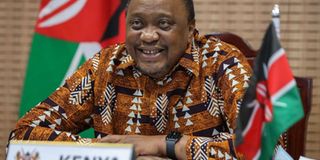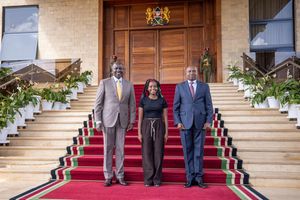Premium
Why it’s a catch-22 situation for Uhuru on easing lockdown rules

President Uhuru Kenyatta PHOTO | PSCU
What you need to know:
- On education, it has generally been agreed that candidates will resume studies in September while other students will reopen after January.
- As the President makes the all-important decision, experts have advised that infections must be contained and headed downwards before he considers relaxing any of the measures.
Opinion was by Sunday night divided on whether or not it’s the right time for President Kenyatta to remove restrictions put in place to contain the spread of Covid-19.
The Nation understands that the national government was prepared to ease movement in the country, on condition that county governments agree to take up “the responsibility and political risk” of the action.
Conversations were still ongoing, with governors being asked to agree on how people would move between the counties and to take responsibility for managing and treating infected people.
But there was general acknowledgement that the level of preparedness in counties is low despite the fact that they have been given money for the task.
RESUME STUDIES
The Nation also understands that it has been agreed that churches, mosques and other places of worship would remain closed until such a time that the protocols and systems for protecting the congregations would be in place.
On education, it has generally been agreed that candidates will resume studies in September while other students will reopen after January.
While the economists have put up a strong fight for lifting of the lockdown in Nairobi and Moyale counties (but not Mombasa), health experts were said to be pushing for even sterner measures in light of the runaway infections recorded in June alone.
As the President makes the all-important decision, experts have advised that infections must be contained and headed downwards before he considers relaxing any of the measures.
Secondly, the health system must be prepared to deal with a surge in infections should it happen.
And thirdly, the State’s security machinery and health authorities should have enough capacity for contact tracing. The idea is to protect the health of citizens as much as possible but at the same time mitigate negative effects on the economy.
SOCIAL GATHERINGS
The measures under consideration include a ban on social gatherings, closure of educational institutions, restriction of movement, border controls, suspension of flights, night curfews, partial or complete lockdowns and use of face masks in public.
A combination of these interventions have substantially slowed down the transmission of Covid-19 and in the process helped to keep infection numbers below scientific projections.
The ripple effect on the disruption of the economy and social livelihoods has, however, been colossal.
Already, the International Monetary Fund (IMF) has said that Kenya’s economy is expected to shrink for the first time since 1990 by 0.3 per cent courtesy of the coronavirus.
At the same time, the World Bank has, in its latest projections, said that Kenya’s “gross domestic product per capita to contract in 2020 — a rare, severe event.”
However, experts warn that without the consideration of all these key questions, relaxing the interventions set by government by 20 per cent would lead to 200,000 infections and 30,000 deaths by December.
A sharp spike in infections over the last one week shows that the country is still far from reaching its peak. Even more worrying is the fact that the number of recoveries has been falling for the last four weeks. In the week that ended on Saturday, Kenya witnessed twice the number of new infections with 1,557 new cases and only 232 recoveries, the lowest number in four weeks.
The number of people confirmed to have fully recovered dropped from an average of 62 per day to 33 in four weeks even as the country’s average number of people reported to have contracted the virus shot up to 222 from 125 over the same period.
INFECTIONS
This means that Kenya’s already burdened healthcare system could, in the coming weeks, be overwhelmed unless something is done to reverse the trend.
Unlike countries like the US and Italy, which were overwhelmed by infections and deaths in just two months, Kenya has had ample time to not only contain the spread of the virus, but to also prepare its healthcare system.
Some African countries such as Rwanda and Uganda have managed to control infections and are preparing to open up their economies on a sure footing. Nevertheless, governors are pushing for a reopening of the economy albeit gradually due to rising concerns about hardships faced by households and businesses.
“After consultations with my colleagues, we advise President Kenyatta to gradually open the economy,” said Kakamega Governor Wycliffe Oparanya, who is also the chairman of Council of Governors. But even more worrying is the fact that only 23 counties have met the level of preparedness set by President Kenyatta last month that will aid them deal with coronavirus should there be a surge in their jurisdictions.
As of Friday the counties had cumulatively set up 9,300 beds, which is about 30 per cent of the required 30,500 units. In their last situation report, the Ministry of Health revealed that only eight counties submitted contact tracing reports and that 28 with active cases did not submit the reports.
This indicates that as the virus is racing through communities, there is little contact tracing and transmissions may get out of control. What this means is that the country is far away from achieving the preparedness threshold required for the economy to be reopened.
A special team drawn from various security agencies working in collaboration with the Ministry of Health has, however, been proactive ramping up Kenya’s contact tracing ability over the last one month. Mobile phone companies are also helping the triangulation of contacts once a suspected infection has been identified, and tracking them.
It’s this ramping up of contact tracing, plus increased testing capacity, that has enabled the government to increase the number of people tested per day, leading to a spike in those who have turned positive.
Thus for President Kenyatta, today’s announcement will be a choice between protecting the lives of Kenyans or their livelihoods.
LOCKDOWNS
Dr Andrew Were, President-elect of the Kenya Medical Association, said the President is in what many consider a catch-22 situation, where leaders, especially in the developing world, have to rethink whether or not to sustain the punishing lockdowns without risking an economic catastrophe, especially for their poorest citizens.
“We have seen an increase in numbers and reports from colleagues in various hospitals that they are overwhelmed, the President has to balance the reopening of the country and ensure the necessary measures are in place to make sure more people are not at risk,” he said.
Dr Majid Twahir, chief of staff at the Aga Khan University Hospital, said so far, hospitals in Nairobi are admitting fairly sick patients, with the asymptomatic ones sent home for home-based care, and this helps in ensuring that the healthcare system is not completely overwhelmed. But he explained that having 300 beds in every county was a great move but the situation needs to be looked at from a different perspective.
“About 80 per cent of patients are asymptomatic, slightly less than 20 per cent have moderate symptoms and may require not only an isolation bed but ones that have oxygen; while 2.5 to five per cent of the patients need critical care, and that is where our problem lies. We don’t just need beds, we need ICU beds,” he said.






